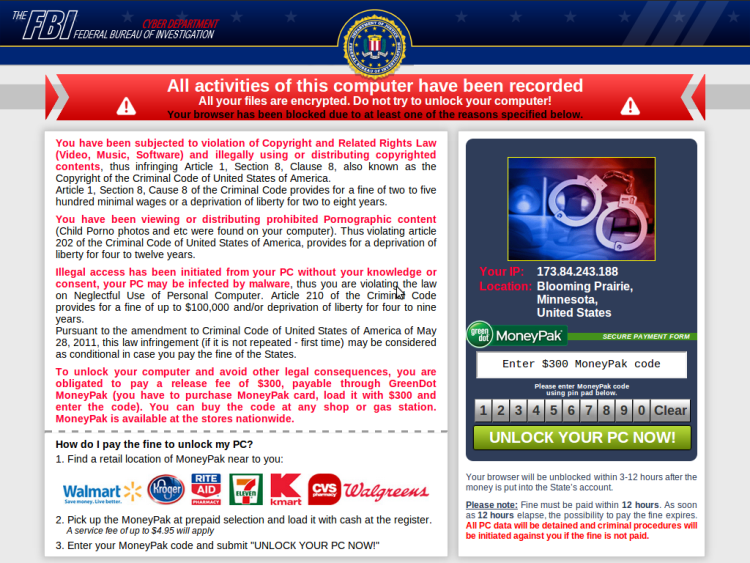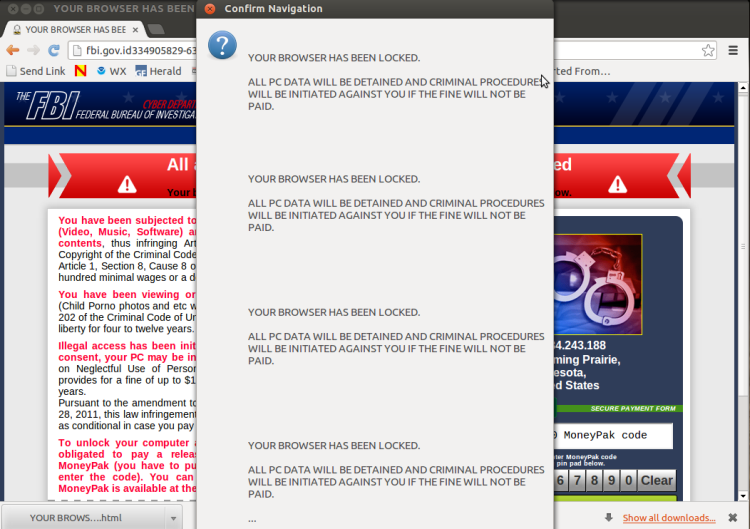Don't fret, it's not, but you may see it on the web
Some legitimate websites may be hacked and the link you click results in seeing this, or similar, page.
Just a picture of a webpage encountered. Looks 'official' but
look it over and continue.

Notice the 'handy' information to purchase a MoneyPak to 'pay the fine'?
And the "UNLOCK YOUR PC NOW" instant MoneyPak redemption area?
DON'T DO IT !
NO U.S. LAW ENFORCEMENT agency uses MoneyPak, PayPal,
or any other 3rd party payment system to collect fines.
Neither do they use these tactics to infer guilt.
Go read the scam warning at https://www.moneypak.com/
Trying to navigate away from the page or attempting
to close the browser results in:

You are stuck on it as you are not able to close the browser. OPTION: Read the What & Why
DO NOT SHUT OFF YOUR COMPUTER Reason will become apparent shortly
Here's what to do in WINDOWS Start Task Manager - Task Manager can be started by right-clicking the taskbar, and then clicking Start Task Manager. You can also open Task Manager by pressing Ctrl+Shift+Esc.
Click on the Applications Tab, find the browser entry.
firefox, chrome., or iexplorer.exe.
Click on it to highlight.
Then click the End Task button May ask for confirmation.
Ok the browser, with the scam Website, is now closed.
NOW do a FULL SYSTEM scan with your anti virus
as it's been known that some
of these pages DO leave behind some crap that may cause problems when
you restart your machine.
I suggest also doing a scan with
Malwarebytes, The
Free version is OK.
The paid version offers you additional real-time protection.
When these scans are done and 'clean' your computer can be considered 'safe'.
Malwarebytes, If not already installed on your machine, may require you to use another computer to download the installer file. Copy it to a USB drive. Move the USB drive to the affected computer to run (install) it.
LINUX has essentially the same but it's known as
SYSTEM MONITOR.
Ubuntu: Dash HOME, enter SYS, click on System Monitor.
Highlight the browser, and KILL Process.
With that you're done. In Linux, it cant leave anything
behind. If it does succeed in leaving something behind, it will
not be able to run as it's written for windows.
RETURN To Computer Tips
Some more info you may find helpful:
Especially the first part on dissecting where this page really
originates.
The web address of an encountered page
http://fbi.gov.id334905829-6328216468.k363471.com/?flow_id=1217&865890=54245/case_id=34344
Looks authentic, The FBI, right? It starts with fbi.gov so it is?
Well it's not,
The scam is quite dynamic in that it may be coming from a different
site, in other instances, but the http://fbi.gov. is consistent.
Oh, the . (period) after gov is a dead 'give-away' that it's not the FBI.
Lets dissect it a bit:
http:// - yep, it's 'on the web'
fbi.gov.id334905829-6328216468. - Sub
Domain of:
k363471.com
?flow_id=1217&865890=54245/case_id=34344 i - s just a bunch of junk.
Going to http://fbi.gov.id334905829-6328216468.k363471.com gets the same page.
So who owns k34371.com?
go to sears.com and click on their store link and the site then could be store.sears.com
Yeah, whatever is first preceding .com, .net, .org, etc to the next
left . is the actual domain
serving the page.
A whois lookup returns :
Domain name: k363471.com
Registry Domain ID:
Registrar WHOIS Server: whois.bizcn.com
Registrar URL: http://www.bizcn.com
Updated Date: 2013-12-23T17:38:05Z
Creation Date: 2013-12-23T22:38:16Z
Registrar Registration Expiration Date: 2014-12-23T22:38:16Z
Registrar: Bizcn.com,Inc.
Registrar IANA ID: 471
Registrar Abuse Contact Email:
Registrar Abuse Contact Phone: +86.5922577888
Reseller:
Domain Status: clientDeleteProhibited
Domain Status: clientTransferProhibited
Registry Registrant ID:
Registrant Name: Whois Agent
Registrant Organization: Whois Privacy Protection Service
Registrant Street: No.
61 Wanghai Road, Xiamen Software Park
Registrant City: xiamen
Registrant State/Province: fujian
Registrant Postal Code: 361008
Registrant Country: cn
Registrant Phone: +86.05922577888
Registrant Phone Ext:
Registrant Fax: +86.05922577111
Registrant Fax Ext:
Registrant Email:
Registry Admin ID:
Admin Name: Whois Agent
Admin Organization: Whois Privacy Protection Service
Admin Street: No. 61 Wanghai Road, Xiamen Software Park
Admin City: xiamen
Admin State/Province: fujian
Admin Postal Code: 361008
Admin Country: cn
Admin Phone: +86.05922577888
Admin Phone Ext:
Admin Fax: +86.05922577111
Admin Fax Ext:
Admin Email:
Registry Tech ID:
Tech Name: Whois Agent
Tech Organization: Whois Privacy Protection Service
Tech Street: No. 61 Wanghai Road, Xiamen Software Park
Tech City: xiamen
Tech State/Province: fujian
Tech Postal Code: 361008
Tech Country: cn
Tech Phone: +86.05922577888
Tech Phone Ext:
Tech Fax: +86.05922577111
Tech Fax Ext:
Tech Email:
Name Server: ns3.cnmsn.com
Name Server: ns4.cnmsn.com
DNSSEC: NotsignedDelegation
Dynamically changing? You bet. Registered just a few days ago.
Creation Date: 2013-12-23T22:38:16Z
To be used for only a few days.
Then register and use another for a few, and repeat.
All automated. No work other than pick up and cash the MoneyPaks.
It's not enough that our government has been selling out this country to the
Chinese,
there are Chinese that are attempting to extort your money also.
Another interesting piece is
Name Server: ns3.cnmsn.com
Nameserver owned or operated my Microsoft? Yup!
cn.msn.com is the Chinese MSN site. MicroSoft Network
RETURN To Computer Tips
It's no secret. Every website knows it. Your address
is needed to send the page to your computer.
But only if your javascript is enabled
your javascript is disabled.
All browsers allow you to disable javascript.
But then, many pages that you go to may not work.
You could disable it, in your browsers settings, and try them.
If you use Firefox, running it in 'Safe Mode' does this.
Start > All Programs > Mozilla > Firefox(Safe Mode)
RETURN To Computer Tips